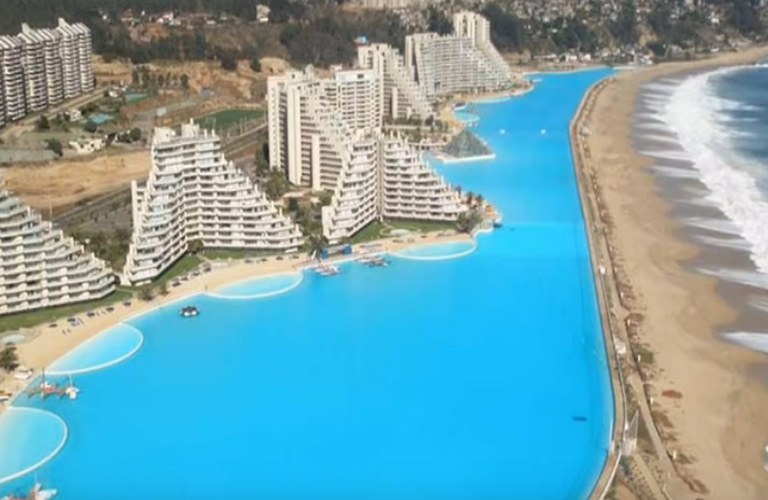The World's Largest Swimming Pool - San Alfonso del Mar
The world's largest swimming pool is located at San Alfonso del Mar resort in Algarrobo, Chile (90 kilometers from Santiago). At the time of its completion in 2006, it was in the Guinness Book of World Records for the largest pool in the world by area.
This impressive saltwater lagoon is the length of over nine football fields, which is more than a kilometer in length, and holds some 250 million liters (66 million US gallons) of water -- the equivalent of 6,000 standard sized pools. There is no hotel at the premises, just apartments to rent from owners. The pool is for residents only but you will have access to the pool if you rent apartment.
During summer, the lagoon maintains a pleasant water temperature that borders 26 degrees Celsius (nine degrees warmer than the nearby sea temperature), and it uses filtered and treated sea water (pumped from the adjacent Pacific Ocean). It's waters are clear with the transparency and intense turquoise color of tropical seas, clean and shark free so you can enjoy your kayak or sail a small boat.
NOTE: The large pool is only for kayak or boat use and water sports, not for swim. You can use smaller pools to swim. Find out more...

"He who does not know the Chilean forests, does not know the planet." ~ Pablo Neruda
:: What You Should Know About Chile::
The Republic of Chile is a South American country occupying a long, narrow strip of land between the Andes to the east and the Pacific Ocean to the west.Chile is the longest north-south trending country in the world, extending across 39 degrees of latitude; strategic location relative to sea lanes between the Atlantic and Pacific Oceans (Strait of Magellan, Beagle Channel, Drake Passage)
Chile borders Peru (168 km) to the north, Bolivia (942 km) to the northeast, and Argentina (6691 km) to the east. Chilean territory includes the Pacific islands of Juan Fernández, Salas y Gómez, Desventuradas, and Easter Island in Oceania. Chile also claims about 1,250,000 square kilometres (480,000 sq mi) of Antarctica under the Chilean Antarctic Territory.
90% of the population is located in the middle third of the country around the capital of Santiago; the far north (anchored by the Atacama Desert) and the extreme south are relatively underpopulated.
Climate: temperate; desert in north; Mediterranean in central region; cool and damp in south. There are four seasons in most of the country: summer (December to February), autumn (March to May), winter (June to August), and spring (September to November).
Chile is located along a highly seismic and volcanic zone, part of the Pacific Ring of Fire, a belt of active volcanoes and earthquake epicenters bordering the Pacific Ocean; up to 90% of the world's earthquakes and some 75% of the world's volcanoes occur within the Ring of Fire. Natural hazards are severe earthquakes; active volcanism (due to more than three-dozen active volcanoes along the Andes Mountains); tsunamis.
Chile is among South America's most economically and socially stable and prosperous nations, with a high-income economy and high living standards. It leads Latin American nations in rankings of human development, competitiveness, income per capita, globalization, state of peace, economic freedom, and low perception of corruption. It also ranks high regionally in sustainability of the state, and democratic development. Currently it also has the lowest homicide rate in the Americas after Canada.
"He who does not travel, who does not read, who does not listen to music, who does not find grace in himself, she who does not find grace in herself, dies slowly."
~ Pablo Neruda





